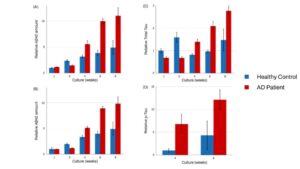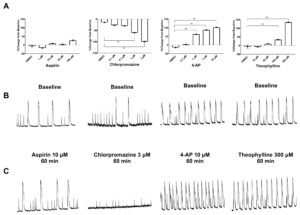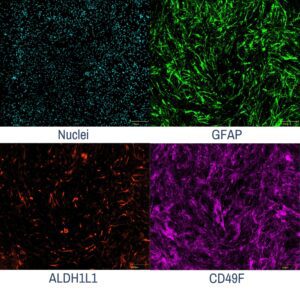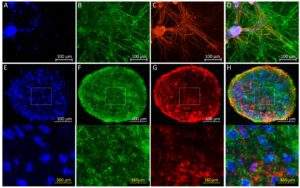Transform your pre-clinical development with Elixirgen Scientific’s innovative iPSC drug discovery solutions.
Drug Discovery Services
Unveiling the Power of iPSC Cells in Drug Discovery
iPSCs: A Revolution in Modern Medicine
Stem cells are undifferentiated cells with the potential to develop into various cell types. Originating from adult cells, iPSCs are reprogrammed to emulate the pluripotency and versatility of embryonic stem cells, offering a sustainable and renewable source of cells for pre-clinical research. Our proprietary transcription factor technology further enhances the potential of this breakthrough by generating iPSC-derived cell types in as little as one week. iPSC’s role in drug discovery has grown increasingly evident as research unveils their capabilities in modeling diseases, enhancing drug testing accuracy, and offering insights into cell differentiation and regeneration. As the demand for functionally relevant models in high throughput assays intensifies, we are confident our advanced technology will provide the acceleration your research requires.
Advantages of iPSC over Traditional Cells in Drug Testing
With a failure rate of nearly 95% for drugs entering human clinical trials, the urgency for more reliable cellular models has never been greater. Despite advancements in animal testing methods aimed at improving predictability, the failture rate has ironically escalated. This is largely due to inaccurate preclinical data and unforeseen safety issues that animal studies failed to anticipate. This is where induced pluripotent stem cells (iPSCs) come into play, offering a groundbreaking advantage in the realm of drug discovery. Here's why researchers are increasingly considering iPSCs in their drug testing protocols:
Advanced Disease Modeling
- Recreating Pathophysiological Conditions: iPSCs derived from patients allow for the in vitro modeling of disease conditions. This provides a platform for understanding disease mechanisms and gauging drug efficacy against specific pathological markers.
- Research Insights: Numerous scientific publications highlight the potential of iPSC-derived disease models in replicating certain human disease conditions, suggesting their potential utility in drug discovery.
Ethical & Sustainable Research
- An Alternative to Embryonic Stem Cells: iPSCs offer a way to conduct research without the ethical concerns tied to embryonic stem cell use. Derived from somatic cells, iPSCs achieve pluripotency, offering a research avenue without certain ethical dilemmas.
- A Future Without Animal Testing: In a monumental decision, the FDA announced in early 2023 that drugs no longer need to be tested on animals prior to introducing them into human trials. With this in mind, iPSCs present a promising alternative. They have the potential to significantly reduce, or even replace, certain animal testing procedures, aligning with the 3Rs of animal research while also providing data more relevant to human physiology.
Potential for Enhanced Drug Efficacy and Safety Profiling:
- Human-Relevant Testing: A primary contributor to the increasing failure rate of animal testing is poor safety profiles that are not predicted through preclinical research or animal testing. iPSCs provide a more physiological representative model to provide insights into drug interactions and potential side effects, potentially reducing the incidence of late-stage trial failures and speeding up the process of drug development.
- Supporting Data: While still an area of active research, some studies suggest that iPSC-derived models might improve the predictability of certain drug responses.
Streamlined Drug Development
- Efficient Cell Generation: iPSCs can be directly differentiated into a wide array of cell types. This direct access reduces the need to source varied cells from elsewhere, expediting research timelines
- Optimizing Resources: iPSCs' reliability and reproducibility help to eliminate the variability of traditional cells, leading to more consistent drug testing results and ensuring that resources are used to their fullest potential
While the full potential of iPSCs in drug discovery is still being explored, their unique properties and capabilities make them a promising tool for researchers looking to expedite the drug discovery process while producing more relevant and applicable data. Our advanced technology aims to harness the potential of iPSCs, supporting research endeavors to realize our vision of supporting today’s scientific research for tomorrow’s medical cures.
Real-world Applications: Success Stories in Drug Discovery Using Stem Cells
Numerous drugs in the market owe their existence, in part, to stem cell-based research. Their applicability in neurological disorders, cardiovascular diseases, and even in certain cancer types illustrates the growing significance of these cells in modern drug discovery. But how can iPSCs help accelerate the drug discovery process for companies looking to save time and money, increase throughput, or reduce their rate of attrition?
Elixirgen's Value Proposition in Drug Discovery
The Investment: Breaking Down the Costs and Elixirgen's Competitive Edge
Drug development is notoriously expensive, with the average cost of bringing a new prescription drug to market hovering around $2.6 billion. Our advanced technology aims to significantly reduce these expenses by offering optimized cost and time efficiencies in drug discovery and streamlining the transition from bench to bedside.
Factors Driving the Cost of Drug Development
- Clinical Trials: Multiple phases of trials that test drug efficacy and safety.
- Research & Development: Constant need for innovation and exploration of new pathways.
- Regulatory Approvals: Ensuring all drugs meet the stringent requirements of regulatory bodies.
How Elixirgen Scientific Offers Cost-Effective Solutions
Elixirgen Scientific, leveraging its expertise in iPSCs, can provide innovative solutions in drug discovery by transforming traditional processes:
- Clinical Trials: Utilizing iPSC-derived models can enhance the predictability of drug response, potentially reducing the length and cost of certain trial phases.
- Research & Development: iPSCs enable a more in-depth exploration of cellular pathways and mechanisms, paving the way for novel therapeutic discoveries.
- Regulatory Approvals: iPSC models may streamline some regulatory processes by providing more consistent and reproducible data, making it easier for drugs to meet the rigorous criteria set by regulatory bodies.
We also offer a competitive pricing model and unparalleled support throughout the life of your project, ensuring your research efforts are streamlined and maximized.
Elixirgen's Role in the Pillar Stages of Drug Discovery
Stage One: Target Identification and Validation
In the initial phase of drug discovery, we offer tools designed to support the identification process. Through our expertise in iPSC differentiation, we provide cellular models that can assist researchers in identifying and validating potential drug targets. These models aim to closely mirror human physiology, offering a valuable resource in the early stages of drug discovery.
Stage Two: Lead Identification and Optimization
Following target validation, the journey to identify potential drug candidates begins. During this process, we provide a range of options, including ready-to-use iPSC-derived cells as well as easy-to-use differentiation kits that empower researchers to create their own custom cell lines in-house. These cells can then be utilized in assays to screen for promising drug leads. Our cellular models also offer a platform that can be employed in the refinement of these leads, balancing therapeutic potential with potential side effects.
Image Source: MDPI, Basel, Switzerland. 2023. Accessed via https://www.ncbi.nlm.nih.gov/pmc/articles/PMC10046961/figure/cells-12-00958-f003/ CC BY-NC 4.0.
Figure 2: High-Throughput Screening of Drug-Induced Oscillation Alterations in hiPSC-Derived Neuronal Cultures: This assay employs synchronized Ca2+ oscillation measurements within human induced pluripotent stem cell (hiPSC)-derived excitatory neurons co-cultured with human primary astrocytes under various conditions. The robust high-throughput nature of this assay facilitates early identification and mitigation of potential seizure risks associated with novel compounds during the drug discovery process.
Stage Three: Preclinical Testing – The Safety Checkpoint
Safety remains a cornerstone in drug discovery. Before any drug advances to human trials, it undergoes rigorous testing. Elixirgen Scientific's cellular models serve as one of the tools available to researchers during this phase, offering a system for preliminary evaluation of a drug candidate's safety and efficacy profile.
Building on this, a recent paper published this year from our parent company Ricoh in collaboration with Janssen Pharmaceuticals, showcased the versatility and potential of our cellular models. Researchers utilized our cells to develop a high-throughput screening assay, specifically designed to detect drug-induced changes in synchronized neuronal oscillations. This innovative approach provides a deeper understanding of potential seizure risks associated with drug candidates. These insights are pivotal for the early de-risking phase, ensuring a more streamlined and safer preclinical safety evaluation process.
Stage Four: Clinical Trials – Elixirgen's Approach from Bench to Bedside
Clinical trials are a pivotal point in the drug discovery process. At Elixirgen Scientific, we recognize the immense complexities and challenges presented during this phase. We offer extensive support during this stage by providing insight into unexpected or adverse side effects, analyzing unanticipated results, and providing additional data where needed. At Elixirgen Scientific, our ultimate goal is to bridge the gap between innovative research and tangible patient benefits, making drug discovery more efficient and effective.
The Elixirgen Timeline: Streamlining the Drug Discovery Journey
The drug discovery process is intricate and time-consuming. Elixirgen Scientific's approach is designed to streamline this journey, offering pharmaceutical research scientists a more efficient pathway from initial research to clinical trials.
Factors Influencing the Length of Drug Discovery Projects
Every drug discovery project is unique, influenced by variables such as the complexity of the drug molecule, the nature of the targeted disease, and the ever-evolving regulatory landscape. We recognize these challenges and have tailored our processes to ensure minimal delays. By employing state-of-the-art technology, integrating feedback loops, and nurturing deep-rooted collaborative partnerships, we aim to adapt swiftly to any project's specific needs, ensuring a smoother progression through the discovery phases.
Fast-Tracking Processes: How Elixirgen Optimizes the Drug Discovery Timeline
Traditional drug discovery can span years, if not decades. Elixirgen Scientific's approach is to compress this timeline without compromising on quality. By leveraging cutting-edge research tools and harnessing the expertise of our seasoned team, we aim to expedite the discovery process. Our commitment is to provide pharmaceutical research scientists with the resources they need to achieve their milestones faster.
Key Protocols and Technologies
Advanced Cell Differentiation Protocols
Our protocols are concise and easy to follow. Regardless of your expertise in iPSC differentiation, our protocols will help to guide your induced pluripotent stem cells (iPSCs) into your desired cell type quickly, easily, and efficiently, ensuring accurate and functional cellular models for drug testing, disease models, and more.
Cellular Imaging and Analysis Techniques
Elixirgen Scientific utilizes imaging techniques, such as immunocytochemistry assays, for a number of different reasons including:
- Verification of Pluripotency
- Confirmation of Neuronal Identity
- Characterization of Neuronal Subtypes
- Disease Phenotype Detection
Gene Expression Analysis
Elixirgen Scientific utilizes assays to gather functional information of genes in the form of expression profiles. This enables researchers to determine the relationship between gene expression variation and the resulting cellular functions and responses.
Protein Analysis Protocols
Elixirgen Scientific has experience running multiple assays to provide rich, quantitative data about cell morphology and protein expression giving researchers valuable insight into cell proteins, their expression, and their function.
Cytotoxicity and Viability Assays
The reproducibility and scalable nature of iPSC-derived neurons make them the perfect option for assays designed to gauge cell health and responses to potential drugs. This empowers researchers with data points ensuring the safety and efficacy of drug candidates in the early stages of drug discovery.
3D Cell Culture Techniques
Image Source: MDPI, Basel, Switzerland. 2023. Accessed via https://www.ncbi.nlm.nih.gov/pmc/articles/PMC10046961/figure/cells-12-00958-f005/ CC BY-NC 4.0.
Figure 4: Immunofluorescence microscopy of iPSC-Derived Neurons Co-Cultured with Human Primary Astrocytes: Representative staining of cell cultures in 2D (A–D) and spheroid (E–H) formats. Nuclei are stained with Hoechst 33342 (A,E), neuronal cells are indicated by MAP2 localization (B,F), and astrocytes are revealed by GFAP staining (C,G). Composite images (D,H) show the merged staining patterns of Hoechst 33342, MAP2, and GFAP for 2D and spheroid cultures, respectively. Insets in (E–H) represent zoomed-in areas of the spheroid cultures, highlighting the cellular composition and architecture.
Our iPSC-derived cells provide a robust foundation for constructing three-dimensional cell models that closely emulate in vivo conditions. By leveraging the versatility of these cells, researchers can generate complex structures such as 3D neuronal spheroids. For instance, our iPSC-derived neurons and human primary astrocytes can be co-cultured to form spheroids, as illustrated in Figure 4. This co-culture technique fosters a microenvironment that recapitulates the intricate cellular interactions occurring in living tissues, thereby enhancing the physiological relevance of cellular assays.
These advanced 3D models are invaluable tools for drug discovery and toxicology studies, as they provide a more accurate representation of cellular responses to pharmacological interventions. By utilizing our iPSC-derived cells in neuronal spheroids, researchers can achieve a higher fidelity in modeling disease pathologies and assessing the efficacy and safety of new therapeutic compounds, thereby accelerating the path from lab bench to clinical application.
Stem Cell Maintenance and Applications
Leverage our unparalleled expertise in induced pluripotent stem cell (iPSC) differentiation. As leaders in the field, we offer streamlined and comprehensive user guides for all of our products, meticulously crafted with the scientist's lifestyle in mind.
With our proprietary technology, we eliminate the complexities of cell differentiation. Researchers can now channel their energy and focus solely on their core projects, bypassing the intricate steps of differentiating their own cell lines.
Moreover, we understand the diverse needs of our clients. Whether you're looking to purchase cryopreserved cells ready for use or prefer our state-of-the-art kits to handle the process in-house, we are equipped to meet all of your research needs.
Assay Development and Design
Elixirgen Scientific offers assay development services designed to help researchers design, optimize, and validate novel techniques for their unique research objectives. Our assays can help to measure specific cellular responses during the drug discovery process, ensuring reliable and reproducible results in drug testing.
Elixirgen’s Expertise in High Throughput Cell Culture
High throughput cell cultures allow for simultaneous testing of multiple compounds. Elixirgen's proficiency in high throughput cell culture ensures that pharmaceutical companies receive reliable and timely results, every time.
Drug Discovery Resources
Drug Discovery Publications
High-Throughput Screening Assay for Detecting Drug-Induced Changes in Synchronized Neuronal Oscillations and Potential Seizure Risk Based on Ca2+ Fluorescence Measurements in Human Induced Pluripotent Stem Cell (hiPSC)-Derived Neuronal 2D and 3D Cultures
Dendritic Spine Formation and Synapse Maturation in Transcription Factor-Induced Human iPSC-Derived Neurons
Synthetic mRNA-Based Differentiation Method Enables Early Detection of Parkinson's Phenotypes in Neurons Derived from Gaucher Disease-Induced Pluripotent Stem Cells
Drug Discovery Webinars:
iPSCs & Microfluidics: Innovative Approaches to Modeling Alzheimer's Disease
Drug Discovery Application Protocols:
Culturing Human iPSC-Derived Mixed Neurons on Multielectrode Arrays: MaxTwo Multiwell MEA
Culturing Human iPSC-Derived Excitatory Neurons on Microelectrode Arrays: Maestro Pro MEA
Drug Discovery Application Notes:
Human iPSC-Derived Excitatory Neurons and Astrocytes Differentiated by Quick-Tissue™ Technology for Functional Drug Screening on MEAs
Visualizing Neurite Outgrowth by Lentiviral Transduction of Fluorescent Proteins into Human iPSC-Derived Excitatory Neurons
Modeling Alzheimer’s Disease with ELISA and Off-the-Shelf Patient iPSC-Derived Neurons
Drug Discovery Posters:
Establishment of High-Throughput Toxicity Assay System with iPSC-derived GABAergic Neurons Generated by a Rapid Differentiation Method
Establishment of High-Throughput Toxicity Assay System with iPSC-derived GABAergic Neurons Generated by a Rapid Differentiation Method
Functional and Pharmacological Evaluation of iPSC-Derived Astrocytes Generated by a Rapid Differentiation Method
Using Human iPSC-Derived Neurons and Astrocytes Produced by Transcription Factor-Based Differentiation Protocols to Generate Models to Study Alzheimer’s Disease In-Vitro
Generation of an Alzheimer’s Disease Model Using Human iPSC-Derived Neurons and Astrocytes Produced by a Transcription Factor-Based Differentiation Protocol
Separation of Drug Effects in Human iPSC-Derived Neurons Using MEA System
Enhance Your Drug Discovery Today
Elixirgen Scientific, Inc.
Science and Technology Park at Johns Hopkins
855 N. Wolfe St., Suite 631
Baltimore, MD 21205





